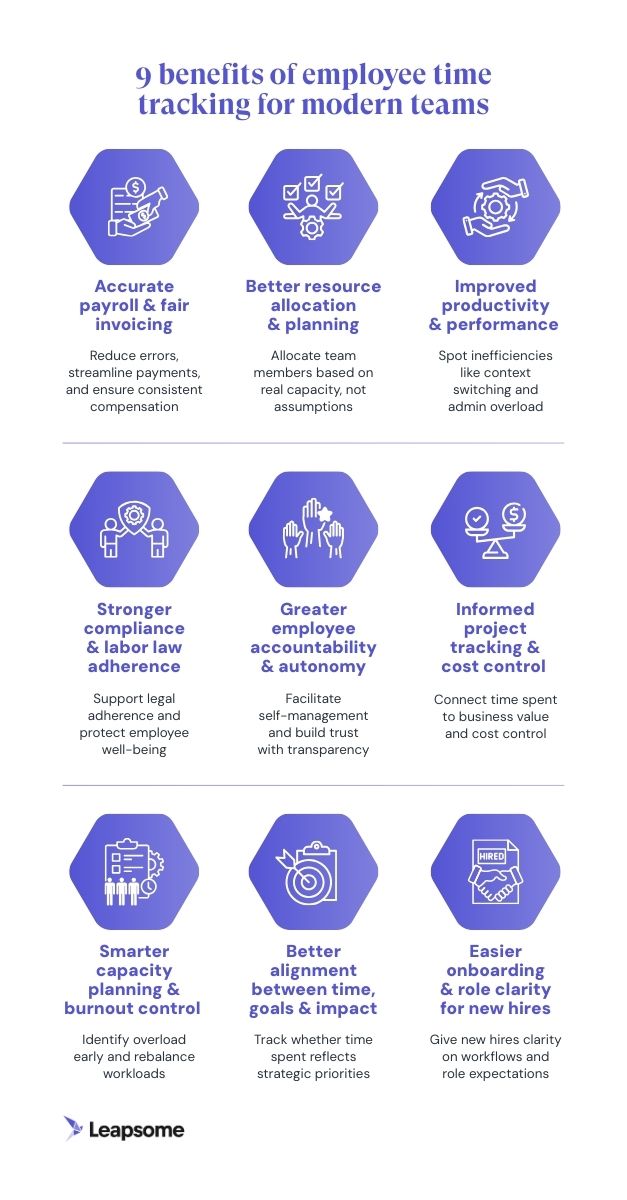9 benefits of employee time tracking for businesses for 2026
Employee time tracking has evolved far beyond punch cards and micromanagement. In today’s hybrid and project-based work environments, time data is critical for performance visibility, resource planning, and compensation — especially when teams are distributed and workloads shift fast.
But how you collect that data matters as much as what you do with it. A staggering 41% of employees report that no one in their organization communicates what data is collected, why it’s gathered, or how it’s used.* This lack of transparency can lead to mistrust, undermining the systems designed to support efficiency, accountability, and fairness.
When implemented with purpose and clarity, time tracking helps HR and business leaders turn insights into impact.
From improving pay accuracy to optimizing project margins, this article breaks down nine business-critical benefits of employee time tracking in 2026, with practical examples and takeaways for today’s teams.
⏰ Use time tracking to improve your business
Leapsome Time Tracking helps HR and Ops teams stay aligned, improve accuracy, and reduce manual overhead.
👉 Explore it now
*Gartner, 2022
Why employee time tracking matters for modern teams
Time tracking isn’t a universal solution — and it shouldn’t be. In cultures that prioritize flexibility and deep work, strict time tracking can feel restrictive. But for many teams, especially those working across hybrid setups, project-based billing, or regulated industries, tracking time is essential on an operational level.
When implemented with clarity and employee buy-in, time-tracking can become a tool for better planning, smarter resourcing, and more equitable workplaces. Especially as teams grow more distributed and AI accelerates work velocity, understanding how to track employee time is critical to optimizing it.
Done right, time tracking can enable teams to work smarter, with systems that support their goals.
The breakdown: top 9 benefits of employee time tracking
Time tracking has earned a reputation for micromanagement, but the reality in 2025 is much more strategic. So, let’s break down nine concrete benefits of employee time tracking with practical examples to help you assess whether a time-tracking system is the right fit for your organization, goals, and company culture.

1. Accurate payroll & fair invoicing
.jpeg)
Manual timesheets and estimated hours are a recipe for payroll errors, delayed invoices, and frustrated employees. Time tracking automates this process: capturing real working hours, flagging inconsistencies, and syncing data directly into payroll systems for faster, more accurate compensation.
This goes beyond getting paychecks right; it can help create a fair, consistent compensation experience for everyone, whether salaried, hourly, or client-billable. For professional services teams, time tracking also simplifies invoicing by providing an auditable record of billable hours that’s tied to specific clients or projects.
Leapsome Time Tracking integrates seamlessly with our Payroll and other HRIS features, ensuring that every logged hour is reflected in compensation workflows. That means no more juggling spreadsheets or manually chasing down corrections at the end of the month. Instead, you get a straightforward, reliable payroll process that can scale with your business, whether you’re using an enterprise solution or time-tracking software for small businesses.<H3> 2. Better resource allocation & planning
Without visibility into how teams spend their time, resource planning is a guessing game. Time tracking gives HR and operations leaders the data they need to allocate work more effectively, not just based on headcount, but on real bandwidth and task distribution.
By analyzing time logs across departments, managers can identify which teams are overstretched, where there’s unused capacity, and when to bring in additional support. It also helps forecast staffing needs for upcoming projects, seasonal spikes, or strategic initiatives.
That’s especially valuable in leaner organizations, where the margin for over-hiring or understaffing is tight. With accurate time data, planning becomes proactive, not reactive.
💡 Top use case: A fast-scaling health tech startup might use time-tracking data to adjust its customer success team structure, reducing onboarding backlogs by shifting internal workflows.
3. Improved productivity & performance
Employee time-tracking apps expose trends that might otherwise go unnoticed, such as task switching, context overload, or time-draining admin work.
One of the biggest culprits is the so-called “toggle tax” — the productivity hit teams take when switching between tools and tasks. According to the Harvard Business Review, employees spend nearly four hours a week reorienting themselves after context switching — the equivalent of five working weeks lost per year. With time data, companies can spot these patterns and simplify systems, tooling, or workflows to reduce friction.
This goes beyond monitoring individual output. Without context, raw time data can be misleading. However, when paired with feedback, goals, and check-ins, it becomes useful input for evaluating workflows and improving how time is spent.
💡 Top use case: A fintech company finds that product managers are losing hours each week to status meetings and duplicate reporting. After reviewing time data, they consolidate meetings and automate weekly updates — freeing up 6+ hours per person per sprint.
4. Stronger compliance & labor law adherence
In many regions (especially across the European Union), employers must track working hours to meet local labor laws. These requirements often include recording overtime and rest breaks, as well as ensuring consistency in how time is logged and managed. Compliance becomes increasingly complex for companies operating across borders or managing remote teams without a centralized system.
Time-tracking software can support compliance by automating work-hour logging, maintaining auditable records, and making it easier to document processes when requested by local authorities. While this doesn’t replace formal legal advice, it can help teams stay aligned with local requirements.
But legal compliance isn’t the only value. Transparent time tracking also helps reinforce workplace well-being by enforcing rest periods, identifying patterns of overwork, and making it easier to apply time-off and break policies consistently across departments.
💡 Top use case: A global SaaS company might use time tracking to enforce mandatory rest breaks in line with a specific country’s labor law, integrating it with Leapsome’s absence management policies to automate compliance checks and reduce HR admin.
5. Greater employee accountability & autonomy
By giving people a clear view of how they’re spending their time.
It can also build trust through transparency. A recent study found that 40% of employees suspect their employer of surveillance, even if no formal tracking exists. That kind of uncertainty erodes confidence and team cohesion. Clear time-tracking policies, with opt-in visibility and shared goals, can remove ambiguity and reframe tracking as a tool for fairness and self-management, not hidden oversight.
This visibility can also enable employees to self-manage more effectively. They can spot where time is being lost, adjust their workflows, and advocate for changes that support better outcomes. Because time tracking provides a shared source of truth, it can build trust, especially in remote or hybrid environments where visibility is harder to maintain without adding meetings or micromanagement.
💡 Top use case: A distributed marketing team uses time tracking to plan weekly focus blocks and reduce interruptions. Over two quarters, they report a 15% boost in on-time project delivery and fewer internal delays.
6. Informed project tracking & cost control
When teams track time by project or task, HR and operations leaders have data to connect effort with outcomes and costs with value. This makes it easier to evaluate project profitability, monitor timeline drift, and spot scope creep early before it impacts delivery or margins.
Time tracking also supports smarter quoting and pricing for future work. Instead of relying on ballpark estimates, you can base forecasts on actual hours using your timesheet template history. This is especially useful for services teams, agencies, and cross-functional initiatives where effort is often distributed unevenly.
💡 Top use case: A mid-sized IT consultancy might use time tracking to analyze project overruns. By identifying high-variance tasks, they can adjust future SOWs and reduce project margin losses by 18% in two quarters.
7. Smarter capacity planning & burnout control
Without real-time visibility into how teams work, burnout often goes unnoticed until it’s too late. Time tracking helps leaders spot early warning signs — like excessive overtime, skipped breaks, or constant context switching — before they lead to disengagement or attrition.
Tracking time at the task or project level also reveals workload imbalances across teams. That insight supports better resource distribution, more realistic project timelines, and smarter planning, especially when managing leaner teams in a high-demand environment.
Importantly, time data should be used to open up conversations, not to penalize individuals. The goal is to support sustainable productivity and reduce overload, not to push people harder.
💡 Top use case: A European design firm could use time tracking to identify chronic overtime among junior team members. After restructuring assignments and adjusting project timelines, they see an improvement in absenteeism rates and a measurable lift in employee satisfaction scores.
8. Better alignment between time, goals & impact
Being busy doesn’t always mean being effective. Knowledge workers spend 88% of their workweek on communication tasks: responding to emails, attending meetings, and messaging through team chat tools. Time tracking gives teams a clearer view of whether their efforts are aligned with strategic priorities — like product development, customer success, or revenue-driving initiatives — or getting lost in low-impact tasks.
When time data is paired with OKRs, team goals, or project milestones, it helps HR and team leads identify where work is misaligned. That could mean too much time spent in status meetings, too many reactive requests, or insufficient focus on high-leverage projects.
This alignment check is instrumental during quarterly planning or retrospectives. It supports better prioritization, helps teams reset when they’ve drifted off course, and ensures resources are directed where they matter most.
💡 Top use case: A mid-market SaaS company analyzes time logs during a strategic review and discovers that customer success managers spend 30% of their time on internal admin. By automating reporting workflows, they can redirect that time toward client retention and improve NRR by 7% in one quarter.
9. Easier onboarding & role clarity for new hires
Time-tracking data can be a powerful onboarding resource. By reviewing how experienced team members spend their time across tasks, tools, and projects, HR can create realistic onboarding paths and ramp-up benchmarks for new hires.
This helps new employees understand not just what their role involves but how to structure their day-to-day. It sets clearer expectations, reduces uncertainty in those critical first weeks, and accelerates the path to productivity.
It also gives managers a concrete way to support new hires early on — by spotting workload imbalances, flagging unclear responsibilities, or identifying when someone is stuck in low-priority busy work.
💡 Top use case: A professional services firm might use time-tracking data to build onboarding templates for new consultants. This can reduce average time-to-productivity and help managers give more targeted support in the first 30 days.
Make time tracking work for your people & your business
.jpeg)
Time tracking isn’t meant to work the same way for every team. But for teams operating in fast-paced, project-based, or regulated environments, having accurate, transparent time data is a major operational advantage.
From more reliable payroll and resource planning to better alignment with business goals, the benefits of time tracking go far beyond logging hours. When implemented with employee trust, clear communication, and the right systems in place, time tracking helps HR and operations teams work smarter, not harder.
Leapsome Time Tracking is part of a flexible, integrated HRIS designed to simplify people management across your organization. Whether you’re working with a hybrid team, adjusting workload, or supporting compliance with regional regulations, Leapsome makes it easy to set policies, log working time, and manage absences — all in one place. With real-time visibility, synced payroll data, and customizable rules by team or location, you can ensure accuracy without increasing admin load.
🧠 Track smarter, plan better
Leapsome Time Tracking is built into our all-in-one HRIS, automatically capturing working hours, syncing with payroll, and reducing manual errors.
👉 Book a demo
Disclaimer: This article is for informational purposes only and doesn’t offer legal, tax, or financial advice. While we’ve done our best to ensure accuracy and completeness, we can’t guarantee everything is up-to-date or error-free. For tailored advice, we recommend consulting a qualified lawyer or tax advisor.
Ready to transform
your People operations?
Automate, connect, and simplify all HR processes across the employee lifecycle.
.webp)
.webp)
 Request a demo today
Request a demo today







.jpg)

.jpg)




















